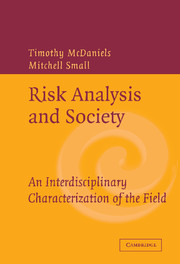Book contents
- Frontmatter
- Contents
- Contributors
- 1 Introduction – Risk Anaysis and Society: An Interdisciplinary Characterization of the Field
- PART ONE FUNDAMENTAL CHARACTER OF RISK
- PART TWO METHODS FOR RISK ASSESSMENT
- 6 Uncertain Risk: The Role and Limits of Quantitative Assessment
- 7 Valuing Risk Management Choices
- 8 The Role of Efficiency in Risk Management
- PART THREE NEW APPROACHES AND NEEDS FOR RISK MANAGEMENT
- SUMMARY AND FUTURE DIRECTIONS
- Index
- References
7 - Valuing Risk Management Choices
Published online by Cambridge University Press: 05 June 2012
- Frontmatter
- Contents
- Contributors
- 1 Introduction – Risk Anaysis and Society: An Interdisciplinary Characterization of the Field
- PART ONE FUNDAMENTAL CHARACTER OF RISK
- PART TWO METHODS FOR RISK ASSESSMENT
- 6 Uncertain Risk: The Role and Limits of Quantitative Assessment
- 7 Valuing Risk Management Choices
- 8 The Role of Efficiency in Risk Management
- PART THREE NEW APPROACHES AND NEEDS FOR RISK MANAGEMENT
- SUMMARY AND FUTURE DIRECTIONS
- Index
- References
Summary
WHY VALUE RISKS?
Risks involve the possibility of damage or loss or injury to individuals or to groups. Whether a risk creates a high level of concern is established through judgments that are made about the definition of the problem, the nature and scope of its consequences, and the likelihood of different exposures. A risk that matters greatly to one person or one group may not be a concern to another because of differences in the context within which it is viewed. This context includes such considerations as the relative importance of other risks, the perception of accompanying benefits, the timing of the expected impacts, uncertainties associated with their receipt, the anticipated response of others, the understanding of realistic alternatives, and so forth. Risk is thus a multidimensional concept, defined differently by different people and in different cultures or at different times to help make sense of, and to create strategies for dealing with, a world that includes perceived dangers and hazards.
All decisions involve some weighing of risks, just as they involve some balancing of costs and benefits. Other things being equal, it is preferable to reduce risks in a given management context. Understanding the values and concerns that arise in the context of specific management options is important, however, because all other things rarely are equal; as a result, decision makers require information about the preferences and priorities of potentially affected individuals or groups toward the relevant set of risks, benefits, and costs.
- Type
- Chapter
- Information
- Risk Analysis and SocietyAn Interdisciplinary Characterization of the Field, pp. 213 - 250Publisher: Cambridge University PressPrint publication year: 2003



